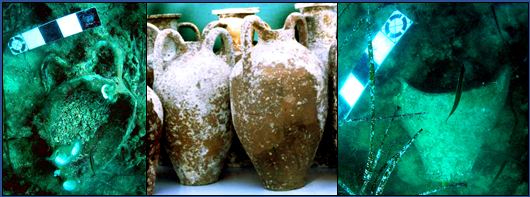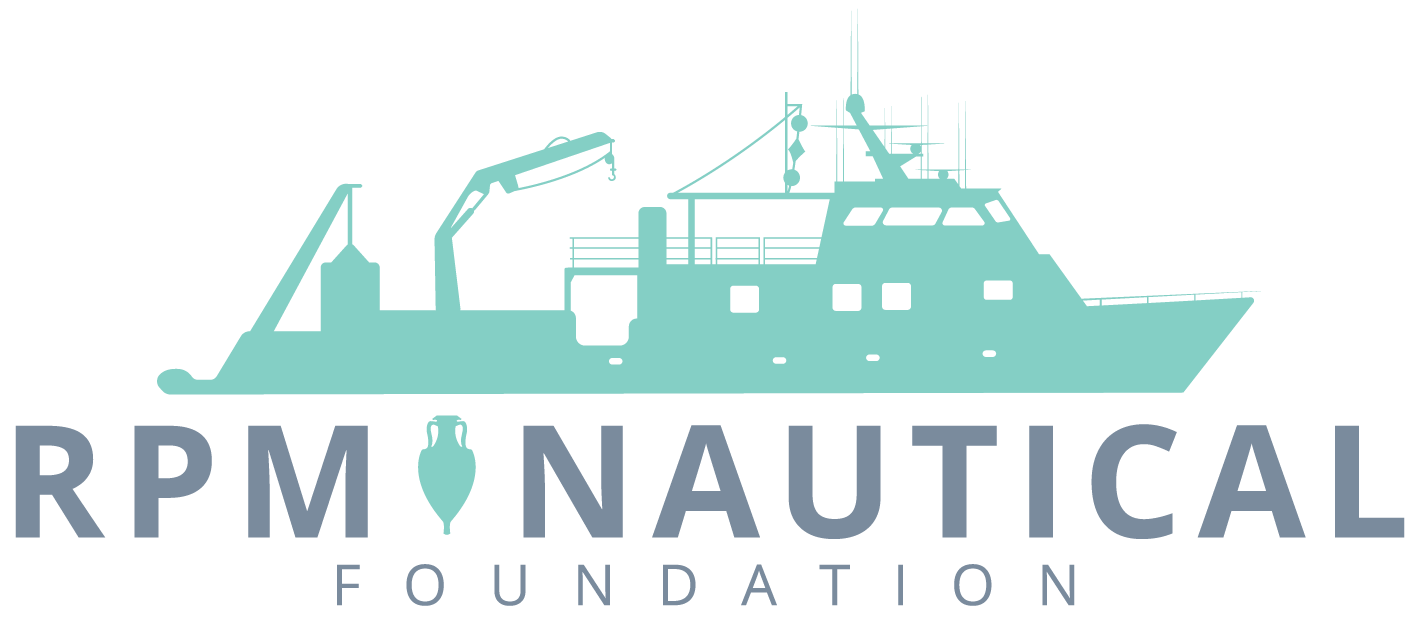 A small bay is situated at the northern portion of the survey area, just north of Sarande, which was investigated by divers over a three day period. The bay is tucked behind a promontory that hides its presence from a vantage point at sea and offers exceptional protection from weather for ships moored here. The seafloor within the bay is covered with a layer of sand and has large patches of sea grass, apparently posidonia. There are also areas of rock outcrops and loose stone much like the rugged hillside surrounding the bay.
A small bay is situated at the northern portion of the survey area, just north of Sarande, which was investigated by divers over a three day period. The bay is tucked behind a promontory that hides its presence from a vantage point at sea and offers exceptional protection from weather for ships moored here. The seafloor within the bay is covered with a layer of sand and has large patches of sea grass, apparently posidonia. There are also areas of rock outcrops and loose stone much like the rugged hillside surrounding the bay.
 During searches along both the northern and southern sides of the bay, divers encountered a wide scatter of pottery. These pottery finds included both amphoras and tableware, many intact, that are located in the shallow portions of the bay (10-20 m of depth). Based upon this initial investigation, the artifact deposit does not appear to form a shipwreck site as there is no discernable artifact concentration. Furthermore, the dispersion of the pottery is along both sides of the bay; further investigation of the deeper portions of the bay with the ROV will be undertaken in 2008. Two types of amphoras were present among the pottery. One distinct type is a pyriform-shaped amphora with a moderately constricting neck. Its arched handles rise from a rounded shoulder high above the mouth and fall to join just below the rim.
During searches along both the northern and southern sides of the bay, divers encountered a wide scatter of pottery. These pottery finds included both amphoras and tableware, many intact, that are located in the shallow portions of the bay (10-20 m of depth). Based upon this initial investigation, the artifact deposit does not appear to form a shipwreck site as there is no discernable artifact concentration. Furthermore, the dispersion of the pottery is along both sides of the bay; further investigation of the deeper portions of the bay with the ROV will be undertaken in 2008. Two types of amphoras were present among the pottery. One distinct type is a pyriform-shaped amphora with a moderately constricting neck. Its arched handles rise from a rounded shoulder high above the mouth and fall to join just below the rim.
At the junction with the neck, the thick handles merge with neck and displace the rim on each side. The handles vary from round to ovoid in cross-section over their length. The body constricts near the rounded bottom and has tightly-spaced ridges along the body. The second type of amphora features small arched handles that rise from the shoulder to above the mouth and fall to join the short neck below the rim. Its handles are ovoid in cross-section with a slight ridge running along their outer side. The rime appears to be a slight beaded one, but only slightly pronounced. The body gradually tapers towards a flat base. Good parallels for both types of amphoras were found on the Çamalti Burnu wrecksite from the NW coast of Marmara Island, Turkey, that is dated to the 13th century CE. The first type of amphoras are clearly a Gunsinen type 3 amphora, while the flat based amphoras are small varieties of the Gunsinen type 4 amphoras. A small, intact table pitcher was located among these amphora finds; it also has parallels with those found on the Çamalti Burnu site. Hence, he pitcher is likely associated with the amphoras, with the overall ceramic deposit having a tight chronological period probably in the early 13th century CE.
Good parallels for both types of amphoras were found on the Çamalti Burnu wrecksite from the NW coast of Marmara Island, Turkey, that is dated to the 13th century CE. The first type of amphoras are clearly a Gunsinen type 3 amphora, while the flat based amphoras are small varieties of the Gunsinen type 4 amphoras. A small, intact table pitcher was located among these amphora finds; it also has parallels with those found on the Çamalti Burnu site. Hence, he pitcher is likely associated with the amphoras, with the overall ceramic deposit having a tight chronological period probably in the early 13th century CE.
